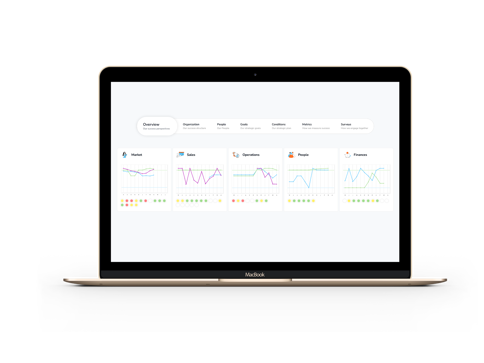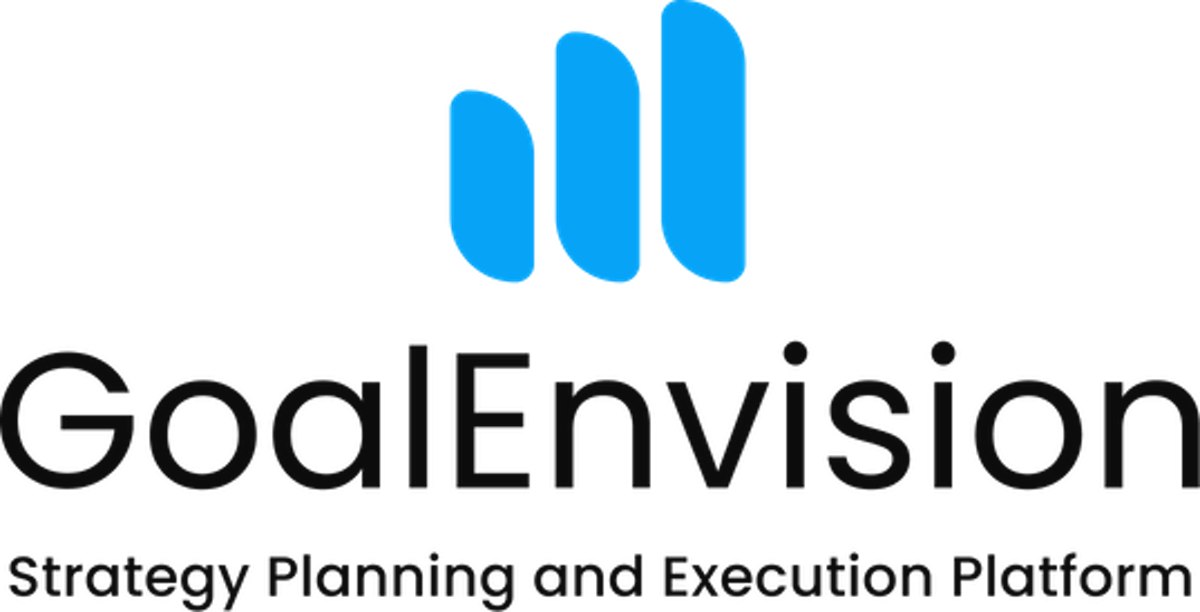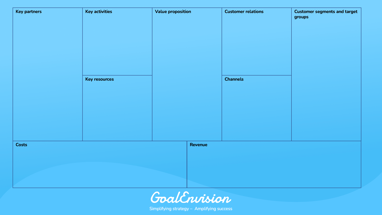Business Model Canvas
Share this article
Welcome to our guide on leveraging the power of the Business Model Canvas. Developed by Alexander Osterwalder and Yves Pigneur, this tool revolutionizes business planning by condensing complex strategies into nine key building blocks. Join us as we explore how to translate and execute your Business Model Canvas effectively using GoalEnvision for ongoing management and success.
In the realm of business strategy, one tool has emerged as a beacon of clarity and structure: the Business Model Canvas (BMC). Developed by Swiss business theorist Alexander Osterwalder and management consultant Yves Pigneur, the canvas has revolutionized the way organizations conceptualize, analyze, and communicate their business models.
Born out of the need for a more flexible and visual approach to business planning, the Business Model Canvas provides a comprehensive framework for mapping out key elements of a business model on a single page. Its inception in the early 2000s marked a departure from traditional lengthy business plans, offering a concise yet powerful tool for entrepreneurs, managers, and innovators alike.
At its core, the canvas serves as a strategic tool for defining and refining business models, guiding decision-making processes, and fostering alignment within organizations. By breaking down the complexities of business into nine interconnected building blocks, it enables stakeholders to gain a holistic view of their business model and identify areas for improvement, innovation, and growth.
In this article, we delve into the practical applications of the Business Model Canvas, offering concrete steps and actionable insights for managers to leverage its potential effectively. From identifying customer segments and value propositions to analyzing revenue streams and cost structures, we explore how each component contributes to shaping a robust and sustainable business model. Join us on a journey to unlock the power of the Business Model Canvas and pave the way for strategic success in an ever-evolving business landscape.
Step-by-step guide to use a Business Model Canvas
Download GoalEnvisions Business Model Canvas template...
While the Business Model Canvas is a valuable tool for business planning and strategy development, it's essential to acknowledge its potential limitations and pitfalls. Here are some common drawbacks and challenges associated with using the BMC:
-
Over-Simplification: The BMC condenses complex business models into nine distinct building blocks, which may oversimplify the intricacies of certain businesses. This can lead to overlooking critical nuances or dependencies within the model.
-
Static Nature: The BMC provides a snapshot of a business model at a specific point in time. However, business environments are dynamic and constantly evolving. As such, a static representation may fail to capture changes in market conditions, customer preferences, or competitive landscapes over time.
-
Limited Strategic Guidance: While the BMC helps identify key components of a business model, it offers limited guidance on strategy formulation and execution. Managers may struggle to translate insights from the canvas into actionable strategies or initiatives.
-
Assumption-Based: Filling out the BMC requires making assumptions about various aspects of the business model, such as customer segments, revenue streams, and cost structures. If these assumptions are inaccurate or based on flawed data, it can lead to misaligned strategies and poor decision-making.
-
Lack of Context: The BMC lacks context-specific guidance, making it less effective for certain industries or business contexts. Different industries may require unique considerations and adaptations that are not adequately addressed by the standard canvas format.
-
Risk of Bias: In collaborative settings, the BMC may be susceptible to groupthink or bias, where certain perspectives or ideas dominate the discussion while others are marginalized. This can limit the diversity of insights and lead to suboptimal outcomes.
-
Complexity Management: For larger or more complex organizations, managing multiple BMCs across different business units or product lines can become challenging. Ensuring consistency and alignment between various canvases requires careful coordination and communication.
-
Tool Dependency: Relying too heavily on the BMC as the sole tool for business planning and strategy development may inhibit creativity and critical thinking. It's essential to complement the canvas with other strategic frameworks, methodologies, and qualitative insights for a comprehensive approach.
Despite these potential flaws and challenges, the Business Model Canvas remains a valuable tool for fostering alignment, facilitating discussions, and gaining insights into business models. By being aware of its limitations and supplementing it with other tools and methodologies, managers can harness its strengths while mitigating its weaknesses to drive strategic success.
Implementing the Business Model Canvas in GoalEnvision:

Once your Business Model Canvas is fully detailed, the next step is to digitize and operationalize it using GoalEnvision for ongoing management and execution.
Set Strategic Goals:
Translate each section of your Business Model Canvas into specific strategic goals within GoalEnvision, setting clear growth targets and strategic goals for every aspect of your business model.
Customer and Market Dynamics:
Input 'Customer Segments' and 'Value Propositions' into GoalEnvisions Market perspective to define your market approach and tailor your offerings based on customer data and feedback integrated within the platform.
Operationalize Channels and Streams:
Use the Sales perspective in GoalEnvision 'Channels' and set up 'Revenue Streams' as financial goals, ensuring your sales and distribution strategies are measurable and attainable.
Resource Allocation and Activity Oversight:
Put 'Key Resources' and outline 'Key Activities' as conditions connected to each relevant strategic goal in GoalEnvision, linking them to team roles and day-to-day operations, facilitating seamless project management and execution.
Partnership Management and Cost Analysis:
Put 'Key Partnerships' also as conditions to each relevant strategic goal in GoalEnvision's collaboration features, and maintain a real-time 'Cost Structure' to monitor expenses in the finance perspective, aiming for cost-efficiency and budget adherence.
Continuous Strategy Refinement:
As your business grows, use GoalEnvision’s analytics to refine your approach, ensuring your Business Model Canvas evolves to meet the changing landscape of your industry.
Implement these elements directly in GoalEnvision for a living, breathing strategy that's as dynamic as your market.
Good luck with your Business Model Canvas!
Share this article
Did you like this article? Here is more...
Latest




